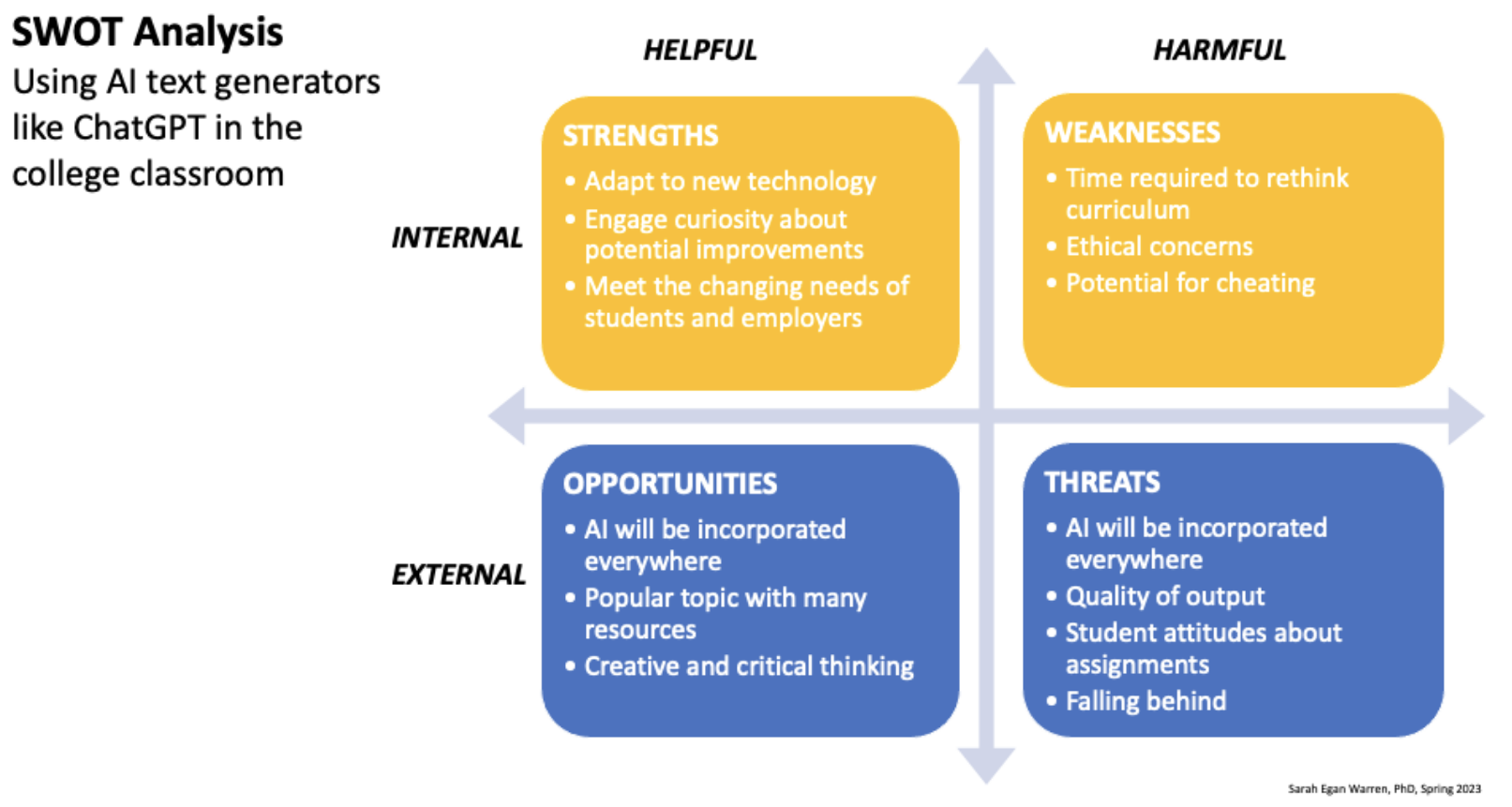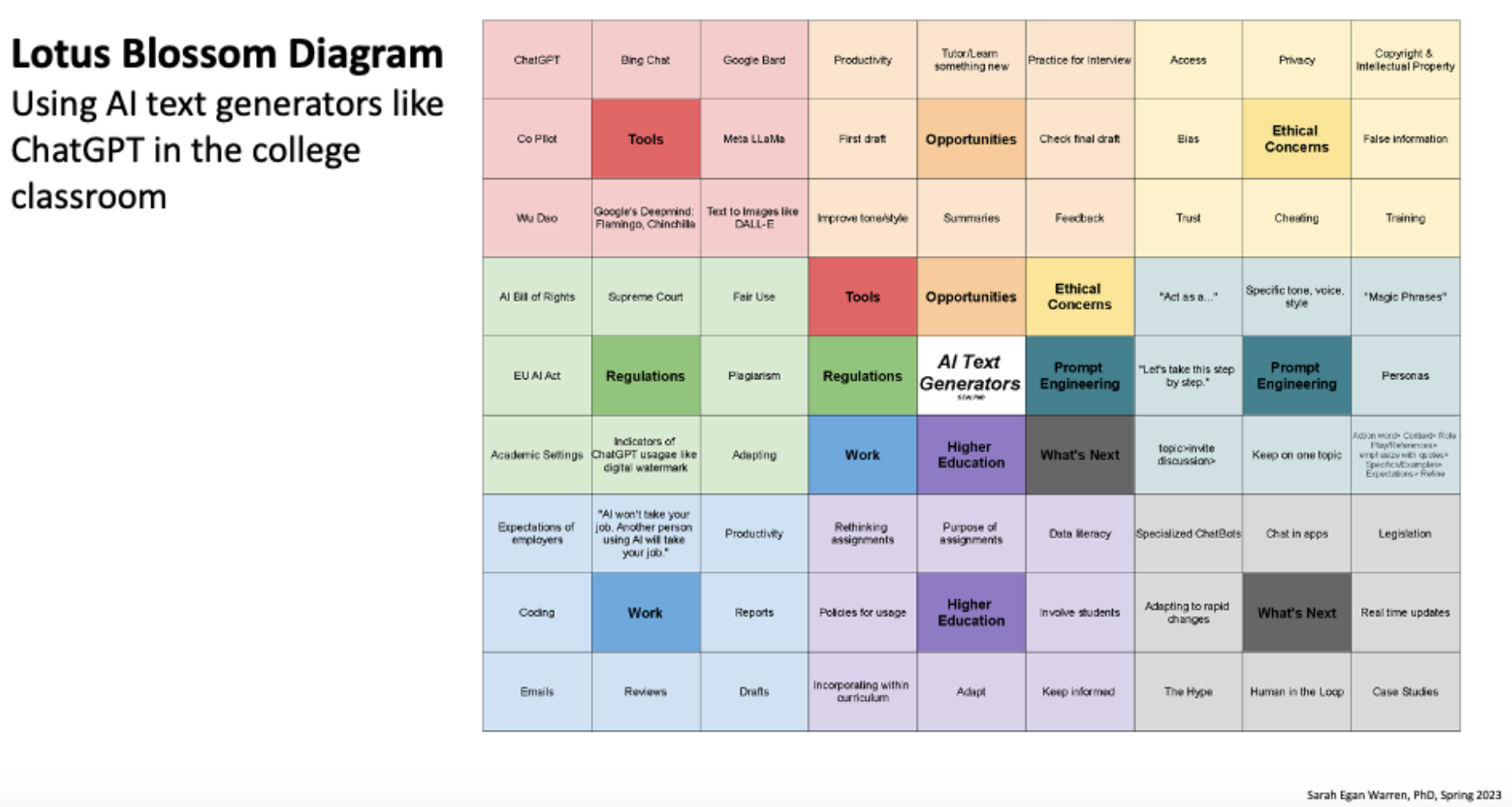Tools to Think Through the Complexities of AI Text Generators in the Classroom

The integration of AI text generators, such as ChatGPT, into our classrooms is a hot topic in higher education (see Three Classroom Strategies for ChatGPT). With the increasing use of AI in our everyday tools and applications, we must carefully consider how to engage with this technology in a responsible and appropriate manner. However, determining the best approach for incorporating AI into our classrooms requires a nuanced approach that cannot be resolved by simply weighing pros and cons.
Fortunately, there are tools to help instructors and administrators navigate these complexities. By utilizing tools such as a SWOT analysis, Edward De Bono’s 6 Thinking Hats, and a Lotus Diagram, educators can effectively brainstorm, consolidate ideas, and critically and creatively evaluate the use of AI text generators in our classrooms and offices.
SWOT Analysis
Although some confusion exists about the originator of SWOT analysis, it is commonly credited to Albery Humprey in the late 1960s. A SWOT analysis is a technique to bring awareness of the Strengths, Weaknesses, Opportunities, and Threats of a project, process, or person.
Simple SWOT Analysis Template Example:

To start a SWOT analysis, an objective is identified by a team or an individual. Then the four-part SWOT matrix is filled in. Note that in addition to the Strengths, Weaknesses, Opportunities, and Threats categories, the matrix highlights the helpful/harmful and internal/external factors that have an impact on the objective. Although a SWOT analysis does not provide solutions, it does create a framework for thinking through strategy and can generate fruitful dialogue.
With the objective of using AI text generators (like ChatGPT) in the college classroom, a SWOT analysis could look like this example:

Note that sometimes ideas can show up in more than one category. For instance, “AI will be incorporated everywhere” can be considered both an opportunity and a threat!
This is not the only way that a SWOT analysis could be done, but this example shows one way to approach it.
Edward De Bono’s 6 Thinking Hats
Edward De Bono published Six Thinking Hats in 1985 describing a process for a group to think through complicated issues. Each of the six hats has a different color that is associated with a different function. The blue hat is for process, the white hat is for facts, the red hat is for feelings, the green hat is for creativity, the yellow hat is for benefits and the black hat is for cautions.
The idea is to put on different hats to look at a situation from different angles or points of view.
Using the complicated issue of incorporating AI text generators (like ChatGPT) in the college classroom, a 6 Thinking Hats analysis could look like this example:

Although intended for a group, it is possible to use the Six Thinking Hats method as an individual as well. Certainly, a group using this technique would generate more discussion and ideas.
Lotus Diagram
Created by Yasuo Matsumura, the Lotus Diagram is a brainstorming technique that encourages critical and creative thinking about a topic. Also known as a Lotus Blossom Map, this visual brainstorming technique provides structure while allowing for plenty of flexibility to explore an idea.
To start, one main problem is centered in a 9×9 grid. Eight core concepts related to the problem are brainstormed and placed around the main idea. Then, those eight core concepts are expanded to include eight keywords or ideas for each. The result is a rich visual that provides ample information about the main problem.
Using the main idea of including AI text generators (like ChatGPT) in the college classroom, a Lotus Diagram analysis could look like this example:

Some concepts may appear in multiple areas of the grid. The nature of the visual encourages creativity because each concept needs eight keywords or ideas. It may be easier to fill in some keywords and harder to fill in others. Some ideas will need to be consolidated, while others may need to be expanded.
These three techniques can help shape dialogue around the responsible use of AI in the classroom. In addition, these are great tools to incorporate into your teaching tool kit to help reinforce critical and creative thinking skills on any topic.


